Tiella Barese is not just a dish, but a true symbol of Bari’s gastronomy and an icon of Apulian tradition.
If you have come here looking for the original and ultimate recipe to prepare a sumptuous tiella of rice, potatoes, and mussels, you are in the right place.
This unique dish, which intensely smells of sea and home, embodies the magic of how simple ingredients – Carnaroli or Arborio rice, yellow-fleshed potatoes, and the freshest mussels – can transform, layer by layer, into an extraordinary preparation slowly cooked in a baking dish in the oven.
In this guide, we will accompany you step by step in creating your perfect Pugliese Tiella, revealing the secrets for a result that faithfully respects tradition, ensuring an authentic and unforgettable flavor.
Get ready to wow your guests with a timeless classic, the pure expression of Southern Italian cuisine.
- Perfect Oven-Baked Bacon: The Secret to an Incredibly Crispy Skin (Guide 2025)
- Oven-Baked Salmon with Crispy Asparagus: Lightness and Flavor Without Condiments
- Oven-Baked Pork Ribs: Sweet and Sour Lime Marinade and Soy Sauce (Easy and Tasty Recipe)
- Creamy Baked Pasta with Ragù and Béchamel
- Baked Gratin Pasta and Cauliflower: Easy and Tasty Recipe
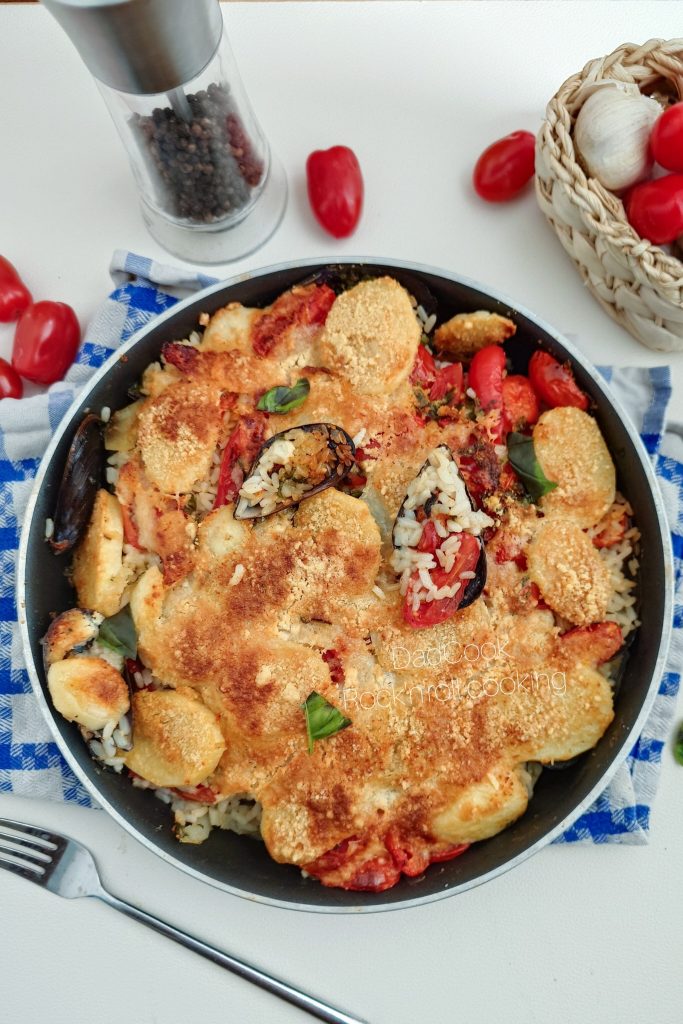
- Difficulty: Very Easy
- Cost: Economical
- Rest time: 10 Minutes
- Preparation time: 40 Minutes
- Portions: 4
- Cooking methods: Oven
- Cuisine: Italian
- Seasonality: Fall, Winter, and Spring, All Seasons
Ingredients
- 10 oz Carnaroli rice
- 2.2 lbs mussels
- 1.1 lbs potatoes (Yellow-fleshed)
- 8.8 oz cherry tomatoes
- 1 white onion
- 1 clove garlic
- 1 bunch parsley
- 2.8 oz Pecorino Romano cheese
- 2 tbsp breadcrumbs
- to taste extra virgin olive oil
- 1 pinch salt
- 1 pinch black pepper
Tools
- 1 Baking Tray Ballarini
- 1 Sieve KitchenCraft
Steps
Cleaning and Opening the Mussels (raw):
First, focus on the mussels. Scrape them well under cold running water to remove any impurities and firmly pull off the beard (the byssus).
Now, with a sturdy oyster knife or a specific mussel knife, gently open them one by one: insert the blade between the shells and carefully pry them open.
Keep the mussel attached to one of the two shells (you can discard the other).
As you open them, collect all their precious water in a large bowl.
Once all the mussels are opened, take their water and filter it very carefully through a very fine mesh sieve (preferably lined with a clean gauze or linen cloth) to remove any sand residue.
Set aside both the opened mussels and their filtered water.

Preparation of Vegetables and Aromatics:
It’s time to prepare the other main characters that will enrich your tiella.
Peel the potatoes, wash them, and cut them into slices not too thick (about 1/8 inch); put them in a bowl with cold water to prevent them from darkening until ready to use.
Wash the cherry tomatoes and cut them in half or quarters if they are larger.
Peel the onion and slice it thinly.
Peel the garlic cloves and finely chop them (or, if you prefer a less intense flavor, you can leave them whole or halved and remove them before serving, although they are usually left in the tiella).
Finally, wash plenty of fresh parsley and chop it finely.
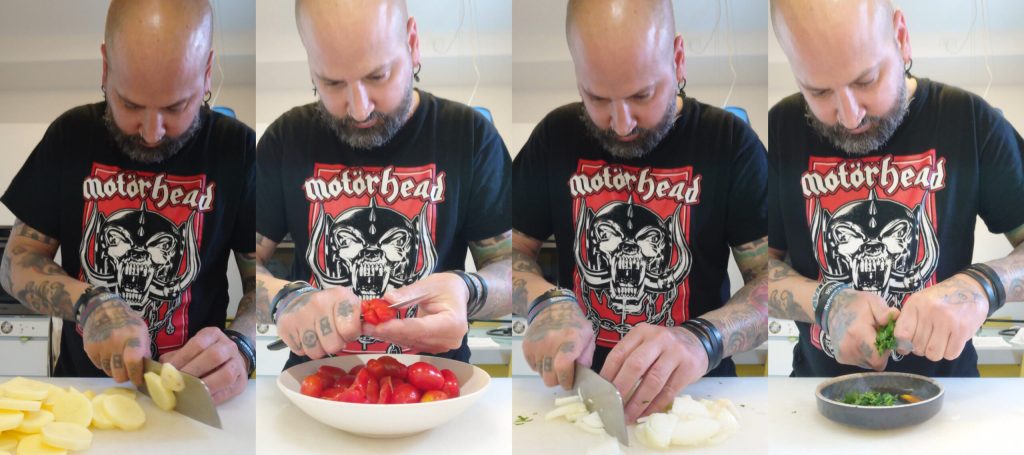
Assembling the Tiella (Layering):
Take your “tiella” or a large baking dish (for 4 people, a round one about 10-11 inches in diameter or an equivalent rectangular one will be perfect).
Generously grease the bottom with a good drizzle of extra virgin olive oil.
Start by creating an even layer with the sliced onion.
Drain the potatoes and distribute about half of them over the onion, slightly overlapping the slices. Season with a pinch of salt (remember that mussels and Pecorino are already salty!), a sprinkle of black pepper, some of the chopped garlic, a sprinkle of parsley, and a drizzle of oil.
Place the opened mussels (with their shell) over the layer of potatoes, trying to distribute them evenly.
Now sprinkle the raw rice evenly over the mussels.
Proceed with the chopped cherry tomatoes, spreading them over the rice. Add the remaining chopped garlic, plenty of parsley, and a generous sprinkle of grated Pecorino cheese. Season again with a drizzle of oil, a pinch of salt (always with caution!), and pepper.
Finish with the other half of the potato slices, trying to cover the surface well. Sprinkle with the remaining grated Pecorino and, if you like a crunchy crust, with breadcrumbs.
Finish with a final generous drizzle of extra virgin olive oil.
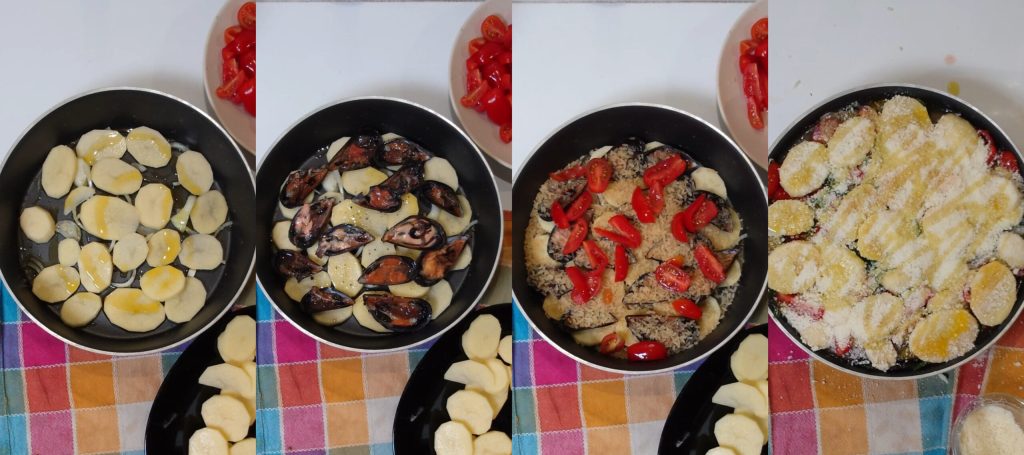
Adding Liquids and Baking:
Gently pour the filtered mussel water you had set aside around the edges of the tiella.
If it isn’t enough to nearly reach the level of the last layer of potatoes (the liquid should be visible, coming almost to the level with the rice or the layer of potatoes covering it), add more cold water or a light vegetable broth.
Preheat the oven to 355-390°F in static mode (not fan-assisted). Bake the tiella on the middle or lower-middle rack and let it cook for about 50-60 minutes.
The tiella will be ready when the rice is cooked, the potatoes are tender (test by piercing a slice with a fork), and the surface is golden and gratinéed.
Tip:
If during cooking the surface darkens too quickly, cover it with a sheet of parchment and aluminum foil (foil) for the last 15-20 minutes to prevent burning.
If it’s too liquid:
If, at the end of cooking, the rice is cooked but there’s still too much liquid, remove the foil (if used) and continue cooking for another 10-15 minutes, perhaps raising the temperature slightly or cautiously using the fan function only for the last few minutes to aid evaporation (watch closely!).
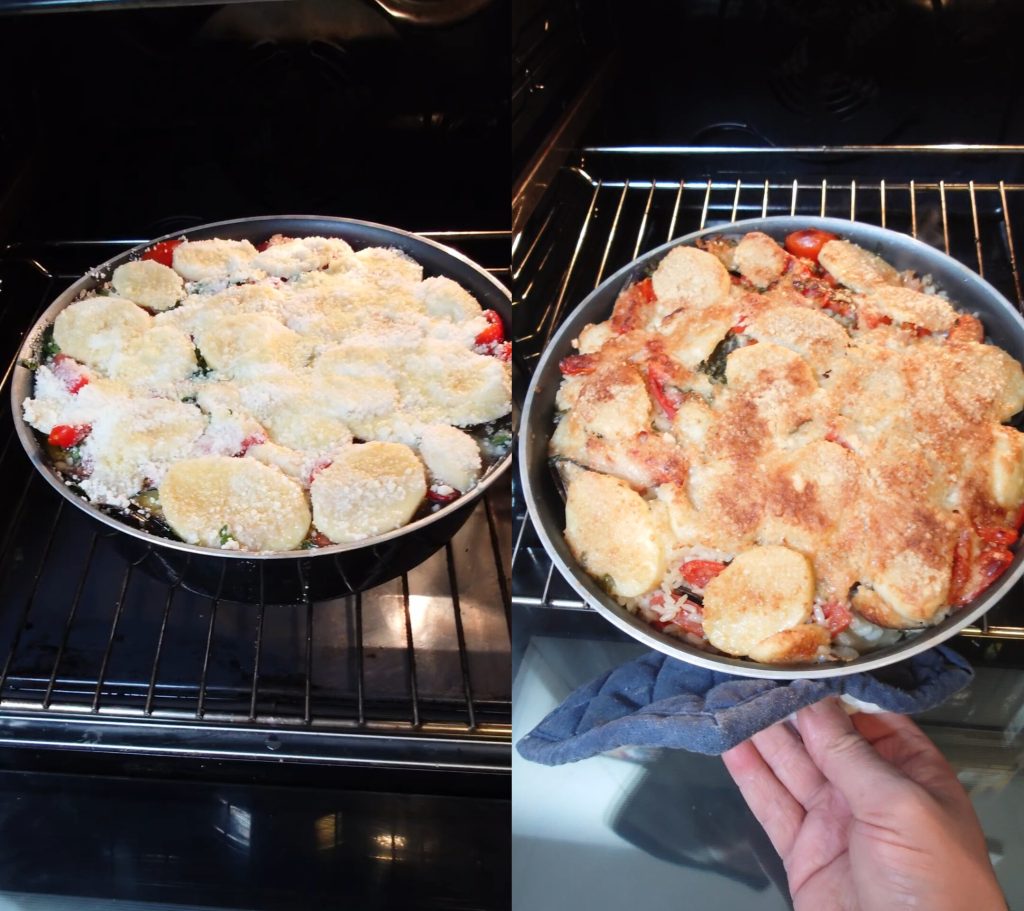
Resting, Plating, and Tasting:
Once out of the oven, let your Tiella Barese rest for at least 10-15 minutes before serving.
This little rest is essential: the flavors will blend perfectly, and the tiella will settle, making it easier to portion.
Serve it warm, directly from the pan, enjoying this masterpiece of Apulian tradition.
Every bite will be an explosion of sea and land flavors!
Enjoy your meal!

STORAGE, TIPS, AND VARIATIONS:
Storage:
Leftover Tiella Barese keeps well in the refrigerator, in an airtight container or covered with plastic wrap, for up to 2-3 days.
To enjoy it at its best, reheat it in a preheated oven at about 300°F for 15-20 minutes until it is hot and fragrant again.
It’s generally not recommended to freeze it, as the texture of the rice and potatoes may suffer.
Tips for a Perfect Tiella:
Superior Quality: The success of the dish greatly depends on the freshness of the mussels and the quality of the potatoes.
Don’t skimp on these key ingredients!
Salt? Caution!:
Remember that the mussels and Pecorino cheese are already salty.
Proceed cautiously when adding extra salt during the layers’ preparation.
The Wonder Water: The water released by the mussels, once filtered, is a true treasure of flavor. Use it as a liquid base for cooking; it will make a big difference.
Patience and Rest: Once out of the oven, let the tiella rest for at least 10-15 minutes.
This small trick allows the flavors to blend and the structure to firm up slightly, easing serving.
Creative Variations (but Respectfully)
Summer Vegetables: If you want to enrich your tiella, you can add a layer of zucchini cut into thin slices, perhaps alternating with the potato slices.
Different Cheese: If Pecorino has too strong a flavor for you, you can opt for Parmesan or a mix of the two.
Some people also use provolone or scamorza pieces for a stringy touch (but this strays from the most traditional version).
A Pinch of Aroma: Besides parsley, a light sprinkle of dried oregano can give an additional Mediterranean scent, especially if you use fresh and sweet tomatoes.

FAQ (Frequently Asked Questions)
FAQ – Frequently Asked Questions about Tiella Barese:
Can I use frozen or precooked mussels instead of fresh ones?
For the most authentic flavor and to use their precious water, fresh mussels are always the best choice.
However, if you can’t find them, you can use frozen mussels (already cleaned or with half shell), fully defrosting them before use.
In this case, you won’t have mussel water, so you’ll need to use a good light vegetable or fish broth for cooking and adjust the salt more carefully.
Precooked mussels are less recommended as they tend to become rubbery with prolonged second cooking.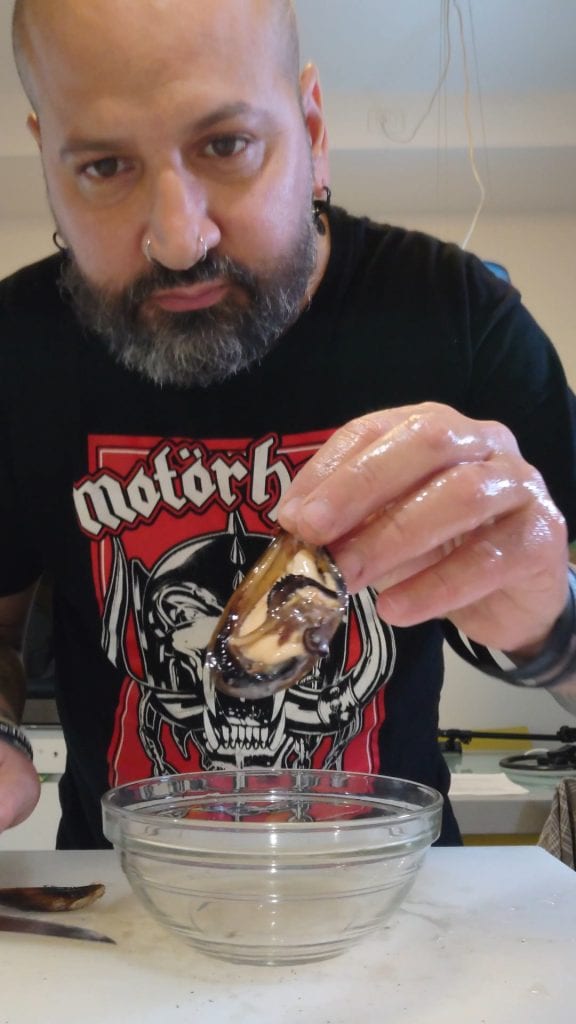
What type of rice is essential? Can I use parboiled or long-grain rice?
The ideal rices are Carnaroli or Arborio (or Vialone Nano), typical for risottos, because they release the right amount of starch and absorb liquids well, maintaining a good hold during cooking.
Parboiled or long-grain rice (like Basmati or Jasmine) have different characteristics and aren’t recommended for tiella, as the final result in terms of texture and creaminess would be very different.What should I do if the tiella ends up too liquid or too dry at the end of cooking?
If it’s too liquid but the rice and potatoes are cooked, remove the foil (if present) and continue cooking in the oven for another 10-15 minutes at a slightly higher temperature (or with the fan function for the last few minutes, watching closely) to evaporate the excess liquid.
If it’s too dry and the rice isn’t cooked yet, cautiously add a bit of hot vegetable broth (or hot water) around the edges and continue cooking until the rice is ready, covering if the surface is already well browned.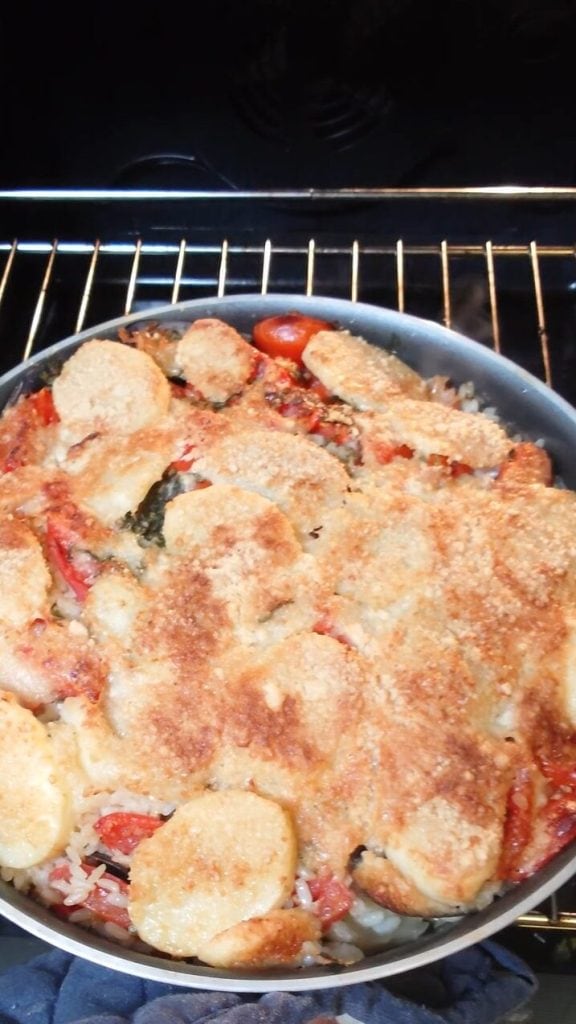
Should the tiella be covered with foil from the start of cooking?
Generally, no.
It’s recommended to start cooking without foil to allow the surface to brown.
If you notice that the top is darkening too quickly while the interior still needs to cook (usually after the first 30-40 minutes), then you can cover the dish with a sheet of aluminum foil for the remaining time.Can I prepare the Tiella Barese in advance?
Yes, there are two ways. You can assemble the tiella with all raw ingredients (without adding the final liquid) a few hours ahead, cover it with plastic wrap, and refrigerate.
Add the mussel water (and extra water/broth as needed) just before baking.
Alternatively, many believe tiella is even better the next day: you can cook it completely, let it cool, refrigerate it, and then gently reheat it in the oven before serving.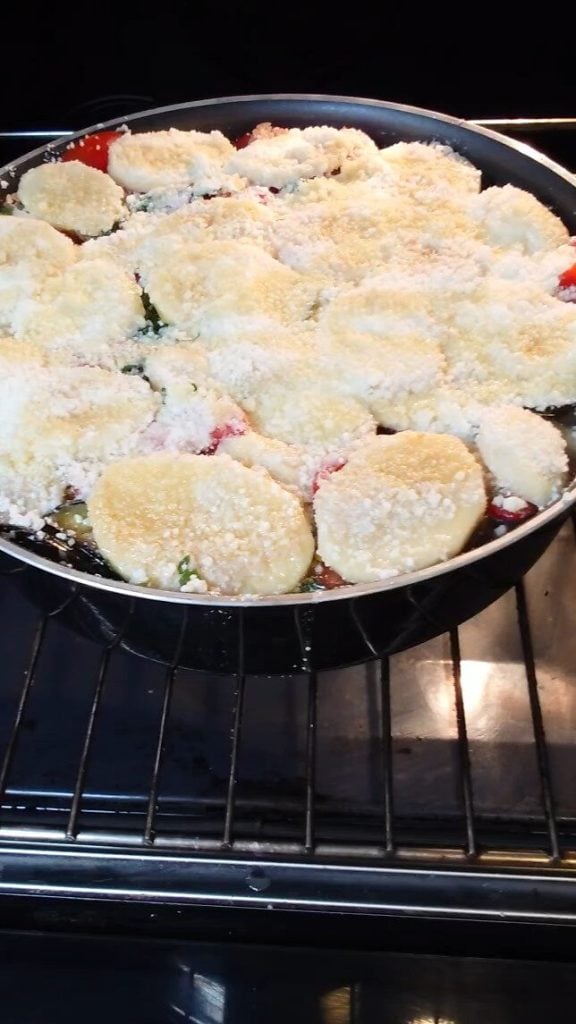
Why do the rice sometimes remain uncooked or the potatoes hard?
The most common causes are insufficient liquid, too low oven temperature, or inadequate cooking time.
Ensure the liquid added at the start nearly covers the ingredients (or at least reaches the top layer of potatoes).
Check the actual temperature of your oven (it sometimes doesn’t match the setting).
If necessary, extend the cooking time, covering the tiella with foil if the surface is already colored, until rice and potatoes are tender.

